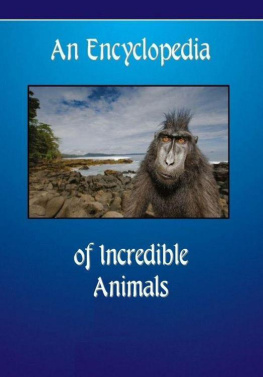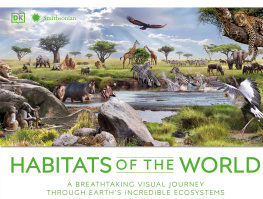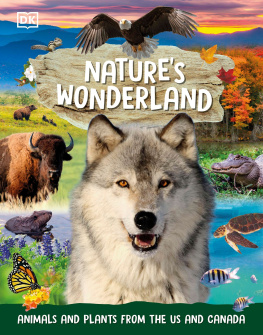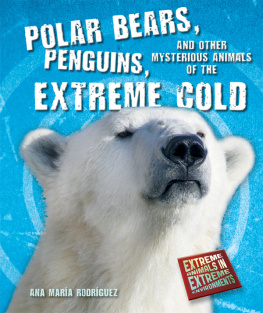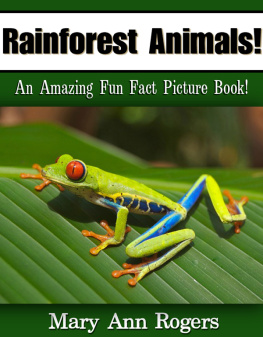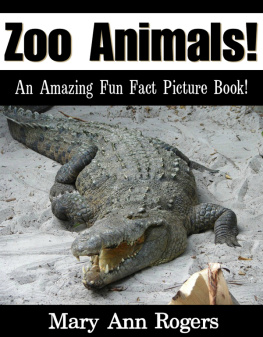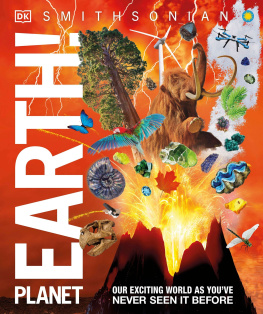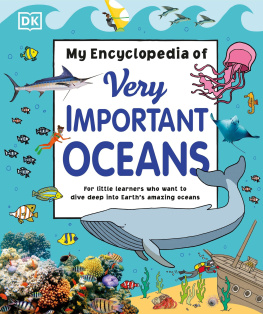CONTENTS
Preface xi Acknowledgments xiii Introduction xv
viii CONTENTS
CONTENTS ix
Alcon Blue Butterfly 173
x CONTENTS
PREFACE
Incredible Animals is an exploration of the animal kingdom, a cherry-picking of these fantastically diverse organisms whose ways and characteristics are astounding and often stranger than fiction. The book covers a wide variety of animal life, including many obscure but exceptionally interesting creatures, the likes of which can only be discovered in the confines of specialized, very inaccessible textbooks. Not only is the diversity of the subject matter unique, but the content has been thoroughly researched for scientific accuracy and is written in a way that it is clear, engaging, and enthusiastic.
The audience for Incredible Animals is basically anyone with an interest in naturethe sort of people who buy books from the natural history section of a bookstore or who enjoy nature documentaries. The main purpose of Incredible Animals is to highlight just how remarkable animals are in a way that just about anyone can read and understand. Textbooks are full of fascinating information, but all too often, they are inaccessible to general audiences. This book provides a bridge to those resources for anyone who has even the slightest interest in the natural world.
In this book, you will find 120 animals separated into one of eight categories. You can dip into the book wherever you want to as it is not laid out so that you have to read it from cover to cover. Each piece contains information on how the animal is classified, what it looks like, how big it is, and where it lives. The main body of the piece is devoted to the incredible natural history or characteristics of the animal. A number of bulleted facts give some extra, interesting information on the animal. Some of the animals in the book can quite easily be found in a backyard or in places that are not that exotic, and in these cases, there is a Go Look! section that gives tips on how and where to find them, how to watch them, and how to look after them in captivity for short periods of time.
It was the initial intention to include a list of Web sites to which the reader could go to find additional information on these animals; however, the content of these sites can never be guaranteed, and with the constant reshuffling of pages on the Web, links can rapidly become inactive
xii PREFACE
or useless. For those readers keen to trawl the Web for extra information, the best way is to type the Latin name, or perhaps the common name, into an Internet search engine. The amount of information on the Web today is such that there will be numerous pages on most of the animals in this book, but only those sites ending in .gov or .edu will carry information that has been thoroughly researched and edited. At the end of many entries, there is a list of resources for further reading. These lists, as well as the selected bibliography at the end of the book, include textbooks and journal articles that can be found in any decent library. Some of these books have an asterisk (*) appearing next to themit is these resources that I heartily recommend you buy as they are a treasure trove of information for anyone interested in the natural world.
Wherever possible, I have tried not to use jargon. There is a whole dictionary of specialized zoological terms, which can sometimes be confusing or difficult to say. I have tried to write in more general terms without using this specialized language. However, there is a glossary at the end of the book to explain any jargon that was unavoidable.
ACKNOWLEDGMENTS
I would like to thank the following individuals for their comments and suggestions on earlier versions of the manuscript: John Alcock, Christian Bordereau, Tom Buckelew, Jason Chapman, Steve Compton, Paul Cziko, Ian Denholm, Stephanie Dloniak, Jack Dumbacher, Mark Eberhard, Howard Frank, Megan Frederickson, Douglas Fudge, Ram Gal, Mike Howell, Robert Jackson, Jeff Jeffords, David Julian, Uwe Kils, Alex Kupfer, Jim Macguire, Andrew Mason, David Merritt, William Miller, Claudia Mills, Sarah Munks, Phil Myers, Dick Neves, Arne Nilssen, Jerome Orivel, Robert Presser, Galen Rathbun, Thomas Roedl, Ernest Seamark, Andrei Sourakov, Erhard Strohm, Paul Sunnucks, Laurie Vitt, Ashley Ward, Marius Wasbauer, and Philip Weinstein. I would also like to thank Mike Shanahan for his brilliant illustrations, Lucy Siveter of Image Quest Marine for sourcing images, Adam Simmons for reviewing an early draft of the manuscript, and Roger Key. I would like to thank Bart Hazes and Mike Howell for going out of their way to help me. Special thanks go to Kevin Downing for giving me the chance to write this book.
INTRODUCTION
The earth, from a purely celestial point of view, is unremarkable. It is a small planet in a solar system orbiting a medium-sized star in a smallish galaxy, the Milky Way, which contains billions of solar systems. The Milky Way is but one of billions upon billions of galaxies in the incomprehensible vastness of the universe. Yet, in one respect, the earth is special beyond compare. It is the only place we know of on which there is life.
Life is such a small, seemingly insignificant word, yet it encompasses a fantastic diversity of living forms. The exact time and nature of lifes appearance on the earth has divided scientists for decades, and it will continue to do so because the time spans with which we are dealing are huge, almost impossible for us to grasp, and the evidence is fragmentary and hard to come by.
What we do know is that the earth is very, very old4.6 billion years old to be exactbut for the vast majority of this time, it was a lifeless globe cooling from the fires of its creation, circling the sun in the young solar system, while being heavily bombarded by asteroids. Over hundreds of millions of years, the earth changed and the asteroid impacts became less frequent. Oceans formed and our planet became slightly more hospitable, but conditions on this primordial Earth were still very different from the comparatively balmy conditions we enjoy today. And then, more than 3 billion years ago, the first life evolved. Where and how are questions we can only make good educated guesses at, but an experiment conducted in the 1950s by scientists in the United States showed that lightning bolts discharged through an atmosphere, the likes of which could have shrouded the young Earth, could have produced biological moleculesthe precursors of the first simple cells. Although these experiments have since been called into question, as more recent findings suggest that the mix of gases used by the scientists to mimic the atmosphere of the young earth was probably inaccurate, they do give us an idea of what may have happened all those millions of years ago. The complexity of these first biological molecules increased over the eons, eventually forming the first self-contained biological systems, which in turn gave rise to the first proper cellsthe first life.
xvi INTRODUCTION
This first life was no more than simple, single-celled organisms, and these organisms had the earth to themselves for a long, long time. In the atmosphere that shrouded the earth at this time, oxygen was as good as absent, but it is thought these first life-forms created oxygen as a waste gas. Over more immense stretches of time, the levels of oxygen in the atmosphere steadily grew until oxygen became quite abundant. Then, around 700 million years ago, this simple life gave rise to increasingly complex forms. From that point onward, the diversity of life on earth exploded. Lots of different life-forms and body plans appeared, some of which were successful, spawning long, unbroken lines of descent, while others disappeared into prehistory. The life-forms interacted with and adapted to each other, becoming ever-more entwined. The incredible diversity of life on earth today reflects the relationship between organisms and their environmentan intricate web of interactions with the continual processes of adaptation and change, fine-tuning every species over time to its environment. Life-forms have become so attuned to their environment that scarcely a niche is vacant; in almost every conceivable habitat on earth, animals can be found. In the deepest parts of the ocean, more alien to us than the surface of Mars, creatures thrive. Even in the coldest and highest places on earth, you would be hard pressed not to see some form of animal life. To us, perhaps the most bizarre place to live is inside another animal, yet many creatures have taken to this parasitic way of life and have become very good at it.
Next page
